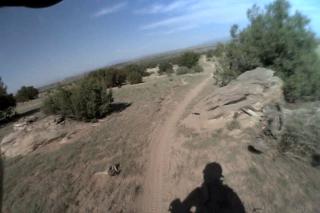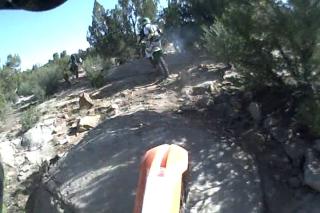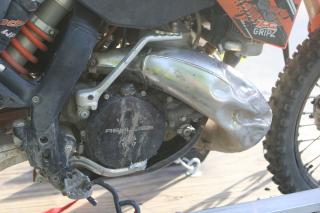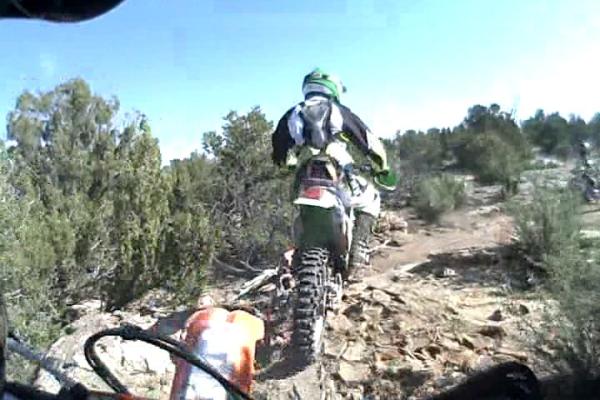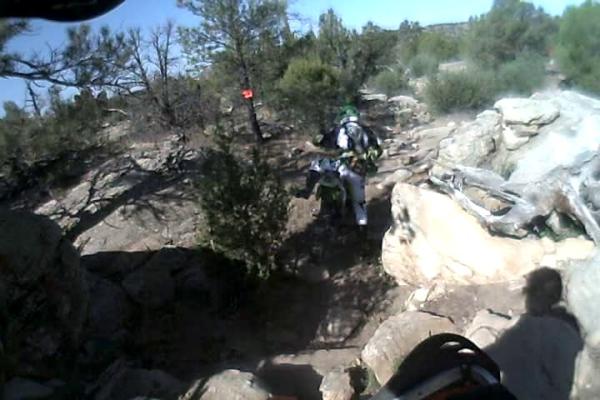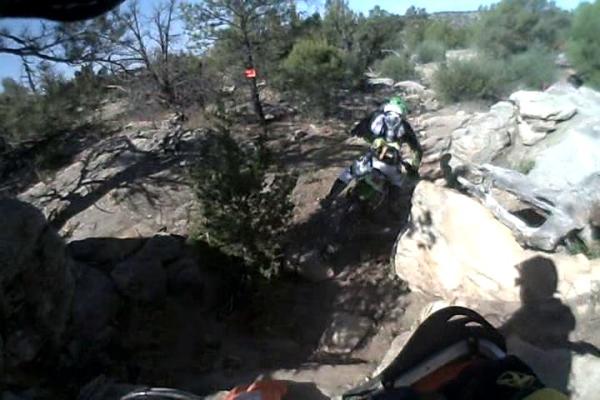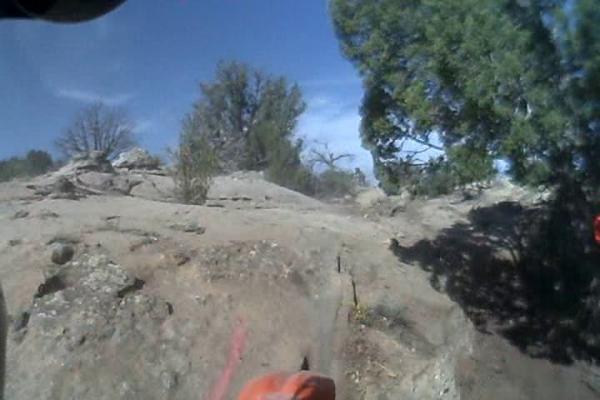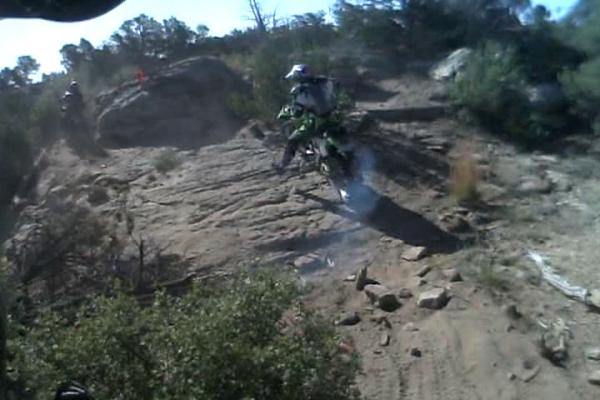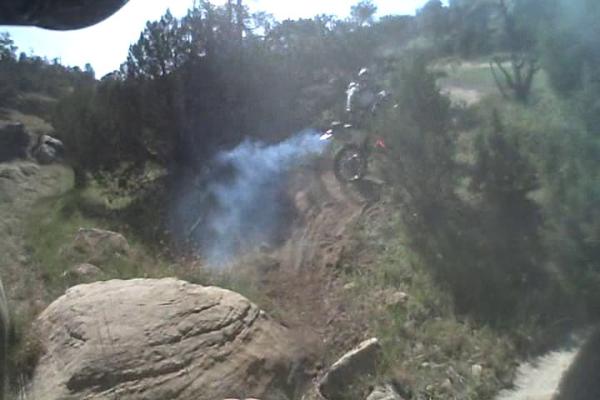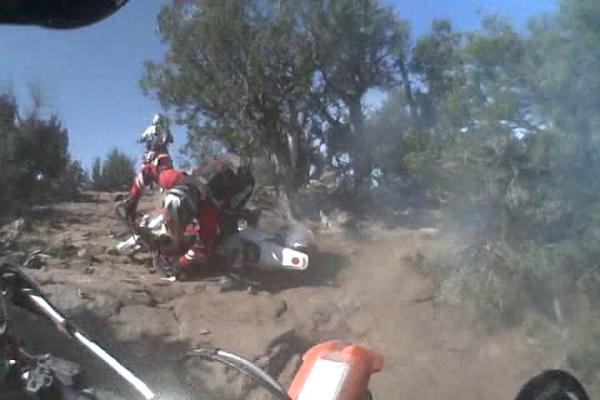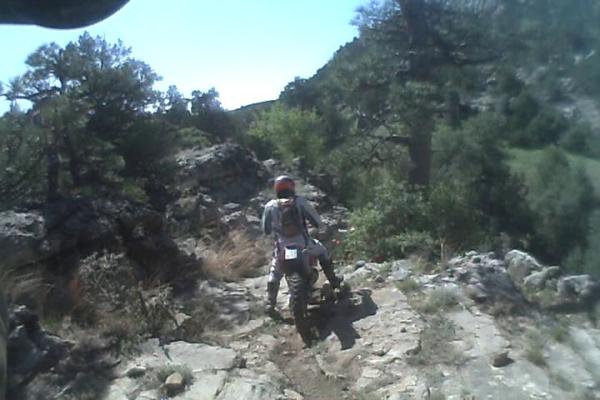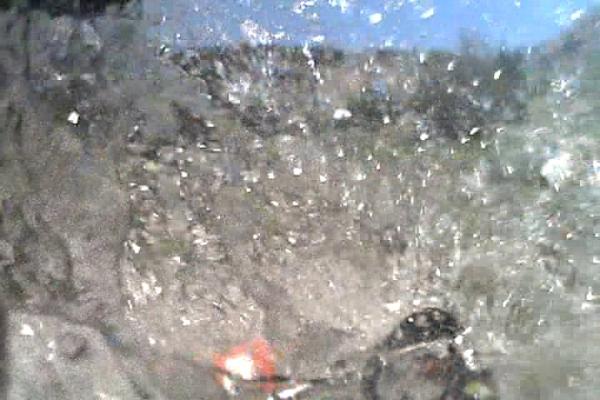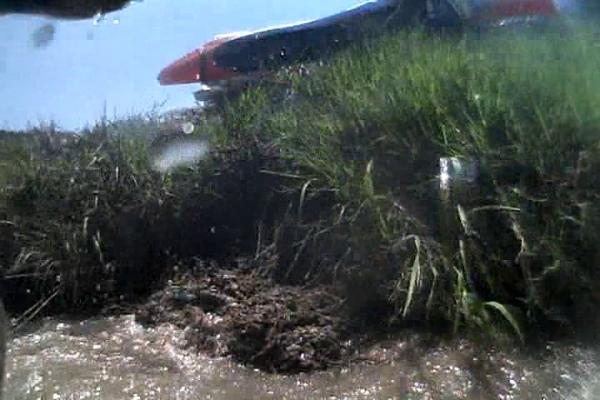The Cucharas River Enduro is held about 17 miles East of Walsenburg, which itself is about 50 miles north of the New Mexico Border, in Colorado, off I-25. Local altitude is 6000' and the forecast was for a high around 80. I couldn't find much information about what conditions to expect at this enduro, other than a short video of one section from a couple years back. Several years ago, there was an ISDE qualifier at the same location. I'd just re-started my summer running schedule, so I figured I'd be in good shape, and I was feeling pretty good about my riding. Anyway, I packed up all my enduro gear, including my winter camping stuff, and set off. On the way down, I picked up "tdoshi9" (Thumpertalk) in Fountain, since he had posted about sharing a ride, and I had an extra slot on my trailer.
Although I fiddled with jetting a little bit on Saturday, I kept it at my normal settings for 5000': 38 pilot, N8RJ-3, approx 1/2 air screw, and a 160 main. Low-end jetting is more important with the Rekluse, since I am more apt to lug it. This tends to put me at air screw settings which are somewhat rich and an increase in temperature can put it a little too rich to idle reliably. So I planned to bring my small screw driver in case minor adjustments were needed on the trail.
In my continuing saga to get contact lenses that work effectively, I had another 2-day old pair for this race. On the topic of vision, after the mud pit of Pine Ridge, I got a pair of the Scott Xi NoSweat goggles with the Works Film System. These were recommended by several racers who indicated they worked better in mud and dusty conditions than tear-offs.
But that was not to be. After the restart there was a very short respite before the rocks continued, and got worse. Soon, there were bikes backed up. Riders would swap places as one would get stock, stall, or have to stop, and the other would pass, only to be re-passed again when he got stuck. We rode over places where the ground was just hard rock; we rode over rock gardens; we rode through deceptive rocky switchbacks between flowing dirt sections. Whenever you came up to a spot and saw a bunch of bikes, it was inevitably a hard hill-climb with some people stuck halfway up, creating a choke point.
The combination of the 250 and the Rekluse proved to work great on this super-rocky terrain, including the steep obstacles and hill-climbs with very little run-up. Usually starting in second gear, the 250 would just emit a low-pitched growl as I deliberately crawled up and over the hills and boulders, modulated by the Rekluse. Although I had a couple tip-overs thus far, my first spectacular crash was going up a steep, rocky off-camber hill that took me by surprise. I slowed due to a stuck rider in my path up ahead, and fell down the steep side of the hill. My bike fell over beyond 90 degrees (wheels above handlebars) and I flew over the stop, did a roll, and came to rest just past a bush. I had to scramble at least 10 feet back up vertically to get back to the bike! In these situations, a little body english applied to the bike to re-orient it to continue helps a lot, and I was able to ride the bike up the remaining part of the hill without issue. As would become a pattern, after wrestling with the bike and making the hill, I needed a break, so I sat on the bike and sucked some water from my camelback.
Each approx 20-mile lap (on the C loop) was made of two test sections, with transit sections in between (and at the begining and end). The first test was about 10 miles and the second test was about 5 miles in length. I made it through the first test, and hoped for some relief, but within a few hundred yards of the checkpoint, the transit got extremely hard and we hit the "crux" of the route: an extremely steep section on rock (with surrounding boulders) that went down probably twenty feet in big steps and around a corner in maybe 25 or 30 feet of distance. There were several riders waiting to go down, two or three in process, and another couple recovering at the bottom. This was so steep most riders I saw were just walking their bikes down, very slowly. A fall here would be painful and hard to recover from.
After this crux section, we were back to extremely rocky sections interspersed with dry, rocky dirt trail. This eventually led us to the first river crossing. On the forums, a big deal was made about these water crossings. At the first crossing, there was a course worker directing riders to a manageable line. I watched a couple go through and it seemed fine: just aim at the route arrow and motor through. It calf-deep and the bottom was pretty stable. I rode through without issue and the water felt good cooling me down. The C route turned right, and we had another water crossing. This one was split in that first you had to cross to an island, then ride along the island for 20 yards, and the finish the river crossing. The first one looked kind of intimidating, but I just aimed for the biggest rut on the far side and rode through, the continued along the island, and just went right through the other side. The far crossing was rocky and had a rock or a hole in the middle, so some "foot paddling" was usually required to keep going.
The second test started shortly after. It was very similar in composition to the first test-- make that extremely rocky, with hard and slow technical sections. About halfway through the last test, the route snaked past the camping area, so it was deceiving that in that you thought you were at the end, but you really had about 3 more miles left to go.
My strategy for the second lap was simply survival. There was no sense in going fast if I was going to crash, and I knew that every time I picked the bike up I lost precious energy. So I was physically beat. Mentally, I knew how hard the different sections were and where the hardest "crux" of the course was. I also knew roughly where the different section were based on odometer mileage. As I came up to the first start control, I was running late and just waved through. This was a pattern for the entire race: I would be behind schedule all the time after mile 3 (the start of the very first test).
My memory of the first lap was like this: rock, rock, rock, hill, rocky, big hill, rock. In reality, I was surprised there was so much easier track the second time through. I guess we tend to remember the hardest parts and ignore the parts that were not punishing. This time around, it seemed like there were fewer riders out there, and fewer pile-ups. However, the abrupt, steep, hard hills still had riders all around and in various stages of getting stuck and un-stuck. It was more common to see riders standing next to their bike with a spinning rear wheel trying to push it up a rock face. My strategy was the same: try to get a good approach, point the bike straight, and just left the 250/Rekluse growl up the hill. It worked awesome. I even passed some stuck guys who had trials tires in the rear: I think the Rekluse makes up for that advantage. It low rpms, it keeps the traction dialed basically perfectly in these tricky situations.
I made it through the first test, then came to the insane descent. As I was waiting, the guy ahead of my fell over and his bike fell on him hard, on the rocks. As I was setting my bike down to go help him, he wriggled free and was able to make it down. I walked my KTM down very slow, to not make any mistakes, and then I had to take a break at the bottom. The guy who crashed had his helmet off and was taking a rest under a tree; I offered him water and others asked if he was OK. Wrestling a bike down over rocks takes it out of you, especially after several hours of doing the same, and falling just makes it worse.
Once I had taken a little break and drank a bunch of water, I kept going, through the rocky singletrack and rock gardens and boulders, to the water crossings. At the first, there was a guy pushing his bike out of the river and then incessantly kicking it trying to get it going. I went across without incident, then followed the C-route split, and came up to the final river: the crossing with the mid-stream island.
Knowing I was tired and lacked arm strength at this point in the race, I was nervous about getting across, so I nailed it and zipped across the water. I carried too much speed up onto the island and I was about to fly over! I managed to get the bike down, but that resulted in my flying over the bike and into the river on the other side. As I splashed I knew I was in for the full treatment, as my head went underwater and I closed my eyes and mouth through instinct. I really wasn't expecting that. Immediately, I rolled over and tried to stand up and climb out, but the current made me hesitate and basically get on all fours to crawl out. Immediately, I picked up the bike and made sure it would start. After a couple minutes of getting readjusted, I headed to the last water crossing and went in. About halfway through I hit the "hole" and had to paddle my feet on the rocks, and just slowly motor through. A guy was totally stuck in the mud rut on the right, so I took the left rut and just motored through, although I did bog down a bit. Once through and on clear dry ground, I had to stop. My goggles were soaked with water and mud, and my boots each had

Taking off, I was now pleasantly cool since I was soaked to the bone. Again, I was waved right through the start control since I was now at least 40 minutes late. The last test was simply pure survival riding, and I took it easy not wanting to crash. By the time I got towards the end, my camelback was again dry - I had drank 100 oz of fluid in a couple hours. As I rolled up to the last checkpoint, I was just dead exhausted, but really glad I had been able to survive and finish the enduro. The header pipe on my KTM was totally smashed, the cumulative damage of over a half-dozen rock hits.
I rode over to our camp, and I was greeted by the other two riders just sitting around having a drink. I'm thinking, "What? Was I that slow? Damn!" It turns out they had both had to bail due to a flat tire and blistering problems.
Contents- 4:38 off-camber hill tumble; 7:39 first big descent; 9:36 first water crossing; 13:15 gas stop; 14:15 Ned Suesse; 19:39 second big descent; 21:36 Nicole Bradford; 22:29 second water crossing; big water crash 24:40; .
In the end, I was 6 minutes short of houring out, and I was 199 points down. I am just happy to have finished this race, and I believe it is a significant achievement. Changes for next time? I would strongly consider using tire balls for this race, to decrease the risk of a flat. I would also start with a full 100 oz of water in my pack, and I would put a couple shop towels in a zip-lock bag so even if I get drenched, I can eventually get clean goggles.
I ran this race mostly in 2nd and 3rd gear, with a few dead-stop hills in first and a few open sections in fourth. The combination of the mild and linear power curve on the 250 XCW and the Rekluse allow me to ride it just a four-stroke that will never stall.
All in all, the Cucharas River Enduro was a damn hard and physically taxing event. I would go again.
The attrition rate was high. Of 263 racers overall, 104 dropped out and 159 finished. Of the 109 C-division racers, 59 dropped out and only 50 finished!
The guys I camped with: Andy & wife, Tony, and RJ, for good times and camaraderie
Elite KTM, for good advice and getting my bike set up on time



